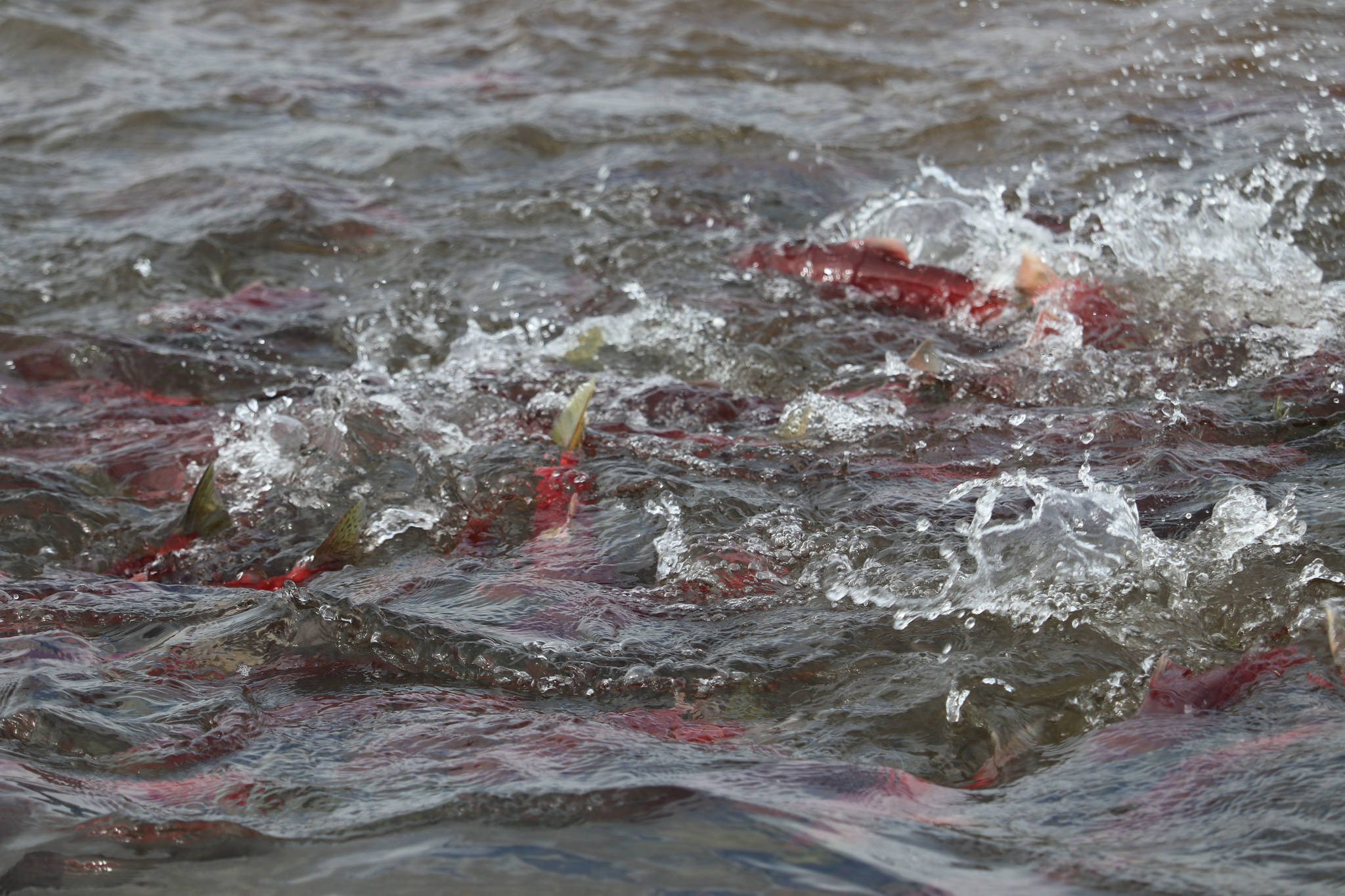As fishermen leave Dillingham and canneries shut down, the Wood River system in the Bristol Bay watershed brims with sockeye salmon.
The second week of August, I got to spend several days upriver. Sockeye schooled at the mouths of small streams off the lake system, their fins cutting through the water. They choked ankle to knee-deep streams more narrow than the width of your dining room table. Females dug redds in the same part of the streams they were born in, fighting off both other females and undesirable males. The bodies of those who arrived before them littered the banks, and as later fish dug redds, unearthed eggs floated downstream, snapped up by opportunistic rainbow trout and arctic char.
And just above the surface, scientists were there to study the fish as they have been each year since 1946, when the University of Washington’s Fisheries Research Institute — now known as the Alaska Salmon Program — was established at the request of several Bristol Bay canneries.
I was up at two of the camps — Lake Nerka, (“nerka,” fittingly, is the Russian name for and the second part of the scientific name for sockeye salmon) and Aleknagik (Nerka is known locally as Second Lake and Aleknagik as First Lake). Over the course of my week there, I helped take genetic samples of fish, went all the way up to Kulik Lake (Fifth Lake, the farthest lake salmon can reach in the system), and learned a lot. Every year, even those who have been coming for more than two decades learn something unexpected, said University of Washington Professor of Aquatic and Fisheries Sciences Daniel Schindler, the scientist who was nice enough to invite me along.
Regardless of how technology develops, there are things scientists see when they’re present in a watershed that would never come across if they studied, say, by drone.
A few recent surprises? The Wood River system has had some “massive caterpillar outbreaks” in recent years.
“Birds, bears, rainbow trout, grayling — all of them are just packed full of caterpillars,” said Schindler.
The caterpillars themselves are packed full of vegetation, which they “obliterate” along the system. By September, though, the alders have re-sprouted instead of turning bright and beginning to die off. To Schindler, that suggests there’s an environmental history of the caterpillars and their interplay on the landscape — something supported by local knowledge.
Another surprise: scientists recently began finding foot-long salmon that had clearly been to sea. They looked like sockeye but they were acting like coho, eating sockeye smolts and feeding aggressively in fresh water. After genetic testing, it turns out they were coho.
A third: There’s a plant, kneeling angelica, that appears to bloom in time with the salmon runs — earlier on colder streams, which is the opposite of what you’d expect.
I’m not a scientist, but my time there was packed with things I found interesting: the size of a stream (so narrow and shallow!) that can support salmon. A ground squirrel crossing the stream on the backs of two sockeye. (Crossing a stream on the backs of salmon may be legends of yesteryear in many river systems, but not in Bristol Bay!) Watching a jack sockeye salmon hide a little downstream, staying in place behind a slight barrier, as a female dug a redd. It crept in whenever a full-size male swam off, only to be chased off by both the full-size male and female or either. (Jack salmon, which return to spawn after just one year at sea and are much smaller than the average salmon, engage in some unique mating strategies in order to pass their genes along.)
Another teacher was the watershed itself: as a formerly glaciated landscape, the Wood River lake system offers a great tutorial on what it is that makes optimal salmon habitat.
“One of the reasons Bristol Bay is productive for salmon is the glacial history,” Schindler told me as we boated past Ott Bay, on Lake Nerka. “Valleys are way bigger than the rivers, and there’s lots of gravel left behind.”
That allows streams to wander around, continuously eroding gravel and helping to create yet more salmon habitat. The lack of development in the watershed is also key: the widest valley in the world won’t help a river wander to create and maintain salmon habitat if infrastructure prevents it.
This year, more than 7.5 million sockeye swam up the Wood River, as per the Alaska Department of Fish and Game’s escapement counts. An estimated more than 33.5 million returned to the Wood, Nushagak and Igushik rivers, including both catch and escapement. As a whole, though late sockeye are still being caught and counted, Bristol Bay blew past its record overall return, with more than 62 million fish as of August 2. Those numbers stand out even more compared with the dismal returns in Kodiak, the Copper River, and many others.
For the next “The Salmon State” column, keep an eye out for a story about how animals that eat salmon “surf the salmon wave” as it moves across the landscape. As you read it, even in September, sockeye will still be spawning in the creeks, rivers and lakes of Bristol Bay.
Mary Catharine Martin is the communications director for SalmonState and an award-winning science and outdoors writer. If you have a column topic to suggest, email her at mc@salmonstate.org.

